Generative AI vs. Human Writers: Why You Need BOTH in Your Strategy
By now, you’ve likely heard about OpenAI’s ChatGPT and other chatbot artificial intelligence tools.
And if you haven’t heard of these AI writing tools yet, settle in and don’t skim over the good parts of this blog because this one is important.
Generative AI has taken the marketing world by storm. With advancements in natural language processing (NLP) and machine learning, AI copywriting has become an increasingly popular tool for any business to interact with its customers — and the multifamily market is no exception to this growing trend.
AI-powered writing tools, in particular, are a leading example of how generative AI is changing the marketing world. But while these tools can automate some multifamily marketing processes, human writers and editors are still essential.
Why? ChatGPT might be revolutionizing how you handle content marketing, but did you know it isn’t always factual? Did you know some generative AI content is considered plagiarism?
We ALL have our limits, and that includes AI writing tools. We found those limits and think sharing them is important so you can utilize ChatGPT (and similar tools) to support your apartment marketing efforts the RIGHT way.

What is ChatGPT?
ChatGPT stands for “Chat Generated Pre-Trained Transformer” and is an AI-powered chatbot that utilizes an NLP model developed by OpenAI. It uses machine learning algorithms to analyze vast amounts of data to generate content that reads as if a human wrote it.
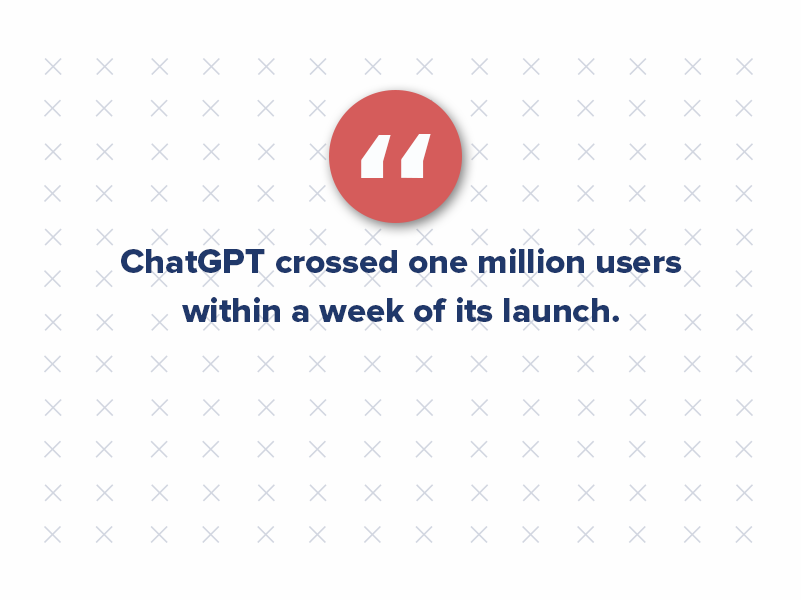
Since ChatGPT launched in November 2022, the world hasn’t stopped talking about it. There are many use cases and ideas, but we haven’t seen enough comprehensive use cases to leverage it in multifamily marketing.
Generative AI Tools and Industry Growth
The generative AI market is booming, with over 2,000 tools now available to help businesses create content, streamline workflows, and innovate across industries. The rapid expansion of this market is fueled by growing interest in AI-driven solutions and substantial investment. In fact, between 2022 and 2023, total investment in generative AI skyrocketed by an astounding 407%. Let’s explore some of the leading tools driving this transformation:
- ChatGPT (OpenAI): A widely used conversational AI tool capable of generating text, answering queries, and assisting with creative projects.
- Google Bard: An advanced conversational AI by Google that excels in generating detailed responses and explanations.
- Gemini (Google DeepMind): Combines generative AI capabilities with Google’s vast knowledge graph for nuanced and reliable responses.
- AlphaCode (DeepMind): A coding-specific AI designed to assist developers in writing and debugging software.
- GitHub Copilot: Powered by OpenAI, this tool enhances coding efficiency by providing contextual suggestions and code snippets.
- Peppertype: Offers content templates for writing articles, meta descriptions, and marketing emails.
- Rytr: Creates SEO-optimized titles, blog posts, emails, and advertisements with a focus on ease of use.
- Jasper: A content generator tailored for marketing teams, featuring multi-language support, collaboration tools, and content templates.
- Copy.ai: Focused on content marketing, this tool generates blog posts, social media updates, and email campaigns.
- MidJourney: A leading AI tool for generating stunning visual designs and artwork.
- Stability AI: Known for developing tools like Stable Diffusion, specializing in high-quality image generation.
A Market on the Rise
The generative AI industry is experiencing unprecedented growth, attracting interest from businesses across sectors. From crafting marketing content to automating repetitive tasks, these tools offer transformative potential. With investment levels surging and innovation accelerating, generative AI is poised to reshape how we approach creativity, productivity, and problem-solving.
Whether you’re a marketer, developer, or business leader, understanding and leveraging generative AI tools can provide a significant edge in today’s competitive landscape. As the market evolves, staying informed and experimenting with these technologies will be key to unlocking their full potential.
ChatGPT by the numbers
- On March 14, 2023, OpenAI launched GPT-4 technology in the ChatGPT Plus Plan, which allows it to generate 25,000+ words in output. As well the model understands 26 languages.
- ChatGPT reached one million users within a week of its launch and 57 million monthly users in the first month.
- ChatGPT crossed the 100 million users milestone in January 2023.
- 13 million individual active users visited ChatGPT per day as of January 2023.
- Microsoft invested $10 billion in OpenAI, gaining 46% of the company’s stake. OpenAI received $ 1 billion from Microsoft in the initial stages of development.
- ChatGPT owner OpenAI predicts that by the end of 2024, they will generate revenue of $1 billion. $200 million in revenue is expected by the end of 2023.
The benefits of AI-powered writing tools
The primary advantage of ChatGPT is its ability to produce large volumes of content quickly and efficiently. This makes it an ideal tool for marketers and content creators who must quickly produce a high content volume. Additionally, ChatGPT can provide marketers with fresh ideas and perspectives on a given topic, helping them to create more engaging and compelling content.
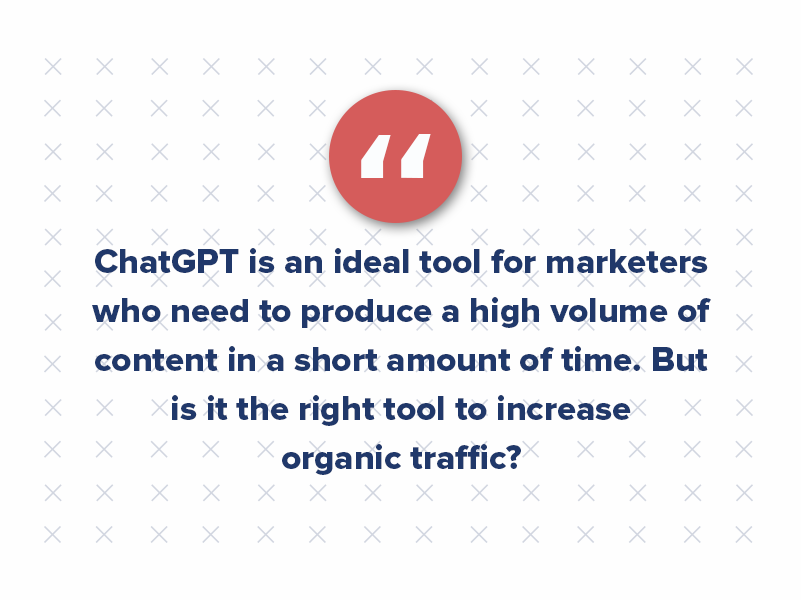
Regarding blog writing and marketing, generative AI is an excellent tool for generating ideas and starting the writing process. By providing a prompt, such as a topic or a keyword, ChatGPT can quickly generate several paragraphs of text that can serve as a jumping-off point for further refinement by a human writer or editor.
Moreover, ChatGPT can help marketers create optimized content for search engines, which is essential for driving website traffic. ChatGPT can suggest keywords and phrases that can improve a blog’s search engine ranking by analyzing search queries and content related to a given topic.
7 limitations of AI in digital multifamily marketing
While generative AI offers several benefits, it is important to understand its limitations. ChatGPT’s writing is generated based on algorithms and statistical patterns, so it may not always capture the nuance or tone that a human writer could convey. ChatGPT also has limited knowledge of cultural and contextual factors that may impact how a specific audience receives content.
Additionally, ChatGPT may struggle to generate content for complex or technical topics requiring high expertise. In these cases, relying on a human writer or editor with the necessary knowledge and experience to create high-quality content may be more effective.

1. AI lacks creativity and personalization.
Despite the many advantages of ChatGPT, human writers and editors are still necessary in today’s marketing world. Human writers bring a level of creativity and personalization to their writing that AI-powered tools cannot match. They can inject personality and voice into their writing that resonates with their audience and helps to build a connection with them.
Furthermore, human writers and editors can provide a level of quality control that AI-powered tools cannot match. They can review content generated by ChatGPT to ensure that it is accurate, engaging, and error-free. They can also ensure that the tone and style of the writing are consistent with the brand’s voice and values.
When you compare content written by AI vs. a human, AI doesn’t have a lot of creativity or personality. Take the following paragraphs as an example. One was generated by AI, and the other by me (the Manager of Content at Criterion.B). I wrote a few paragraphs about web design — specifically, the No. 1 mistake marketers make when building or redesigning their websites.
After writing my version of the topic, I asked ChatGPT to “Write a couple of paragraphs about the No. 1 mistake marketers make when building or redesigning a website.”
Here is my take on the results:
I ran both pieces of content through a plagiarism checker. My content had 0% duplicate content. Meanwhile, 5% of the AI-generated content was considered plagiarism.
Additionally, as you can see, my content was much more informal, specific, and personalized. The AI-generated content (while it is good content) is much more formal, structured, and even a little bit stale in comparison.
While it’s not a bad paragraph and could be used in a blog somewhere, imagine an entire blog written using ChatGPT and how it would sound. The AI-generated content is a bit heavier to read, which could lead to a higher bounce rate over time if all your content is AI-generated.
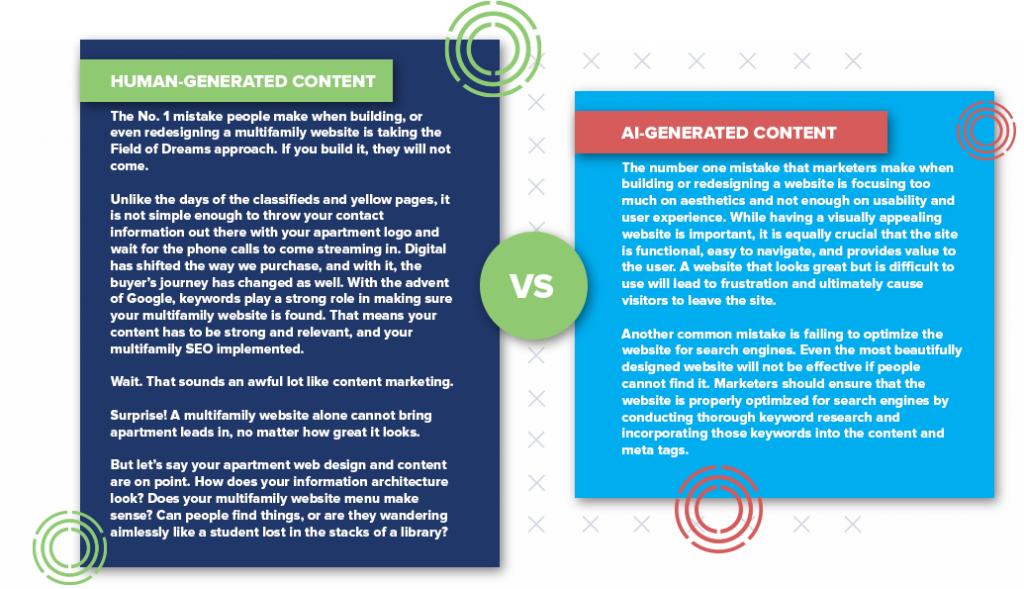
2. AI lacks originality (possible plagiarism alert!)
ChatGPT is not your content creation savior. Sure, it’s powerful and helpful, and maybe the tool will improve significantly in the months and years to come. But for now: relying on ChatGPT for ALL of your content is a disaster waiting to happen.
AI learns from existing content on the web, so it replicates what is already out there. This means it could be a literal copy of something else online. (See the above example where the AI-generated content had 5% plagiarized content.)
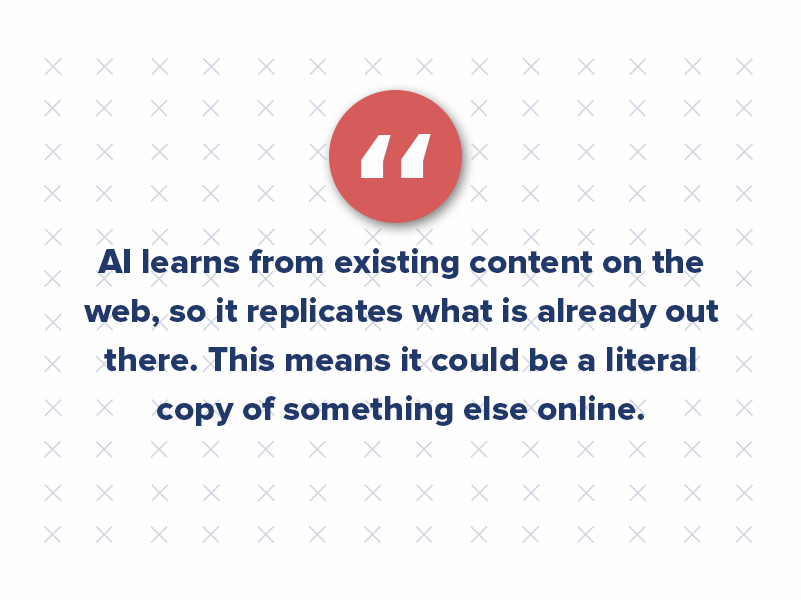
3. AI utilizes an outdated learning model.
Generative AI cannot always provide the correct answers. Did you know that some content from ChatGPT and other writing tools is inaccurate information? This is because AI pulls data from top ranking articles or from what it can find online, so the stats you might see in your content might be inaccurate, outdated, and likely inaccurate. Think about the disclaimer provided in all generative AI results about how it’s “experimental” and users should always fact-check the results.
4. AI lacks emotional intelligence.
AI may be able to simulate human writing, but it lacks emotional intelligence. Human writers and editors can use their emotional intelligence to understand customer needs and write specific content centered around those needs. Emotional intelligence is crucial to successful multifamily marketing, as customers are more likely to engage with a business that understands their needs and values.
5. AI does not know your brand voice.
Every business has a unique brand voice and tone representing its personality and values. Human writers and editors are essential for maintaining and developing a consistent brand voice across all apartment marketing channels. Artificial intelligence tools may be able to write blogs, emails, and website content, but they cannot understand your authentic brand voice. ChatGPT has a lack of context, so AI is not recommended to be used by businesses. The bottom line: Generative AI does not know your business like you do.
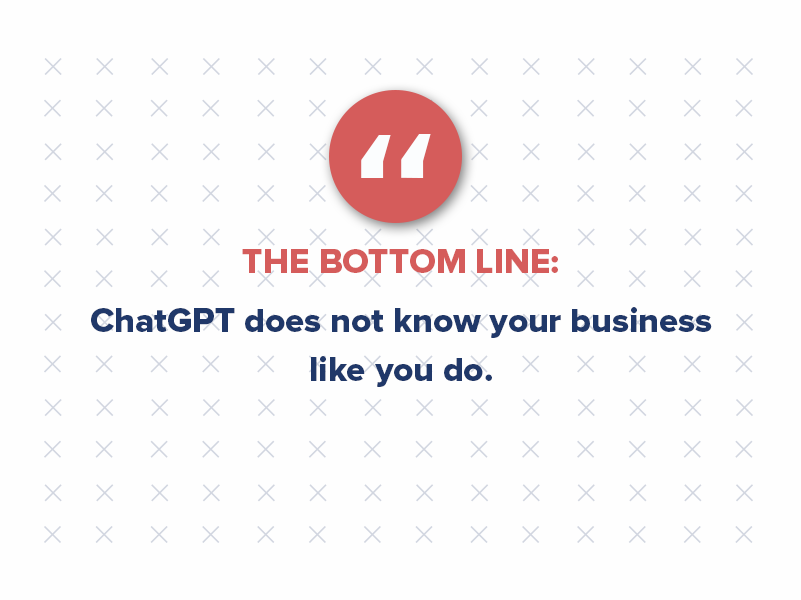
6. AI content has errors.
We are all human (except AI, ha!) and make mistakes. But when you rely on an AI writing tool to generate content for you, you expect it to be nearly flawless. Or, at the very least, free from major errors.
I’ve been testing ChatGPT and other writing tools like Jasper.ai for several months and discovered the content is riddled with errors. Everything from run-on sentences and passive writing to missing punctuation and duplicate content.
Consider the below example. Jasper.ai generated the first paragraph and includes a variety of grammatical errors. While these errors are insignificant, they are still errors that would not be there had human-generated content. Then, compare the “After” paragraph, which is the same AI-generated content that was then edited by me (an actual human editor). Notice the difference in the paragraph’s flow, clarity, and readability.
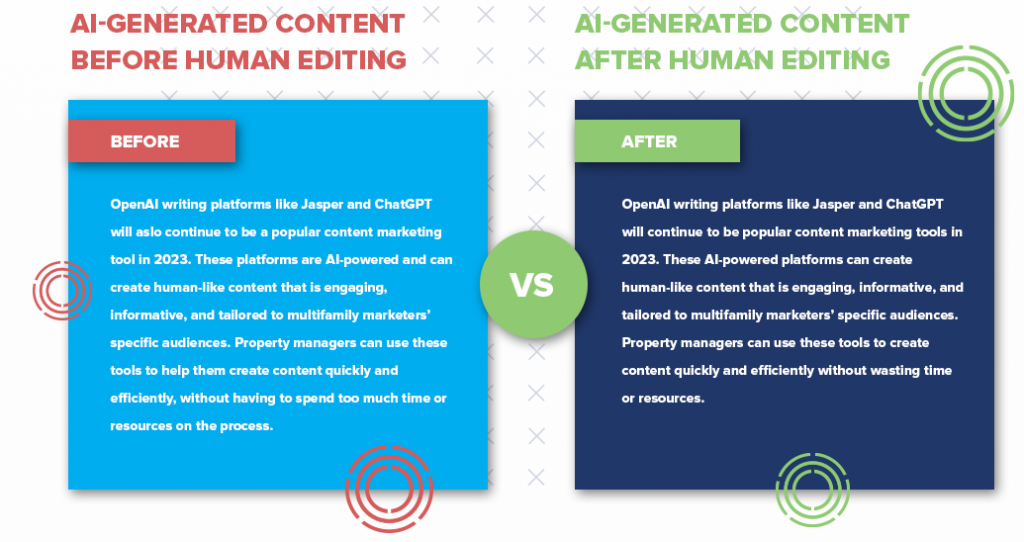
Although Google doesn’t penalize grammar and spelling outright, the bots that scan your content may find it harder to understand what the page or article is about, which could result in lower page rankings and perceived credibility.
7. AI content is not guaranteed to rank well.
Fun fact: Google doesn’t love AI-generated content. Google did release its own AI writing tool, Bard, so the space may change in the coming months and years, but for now, Google can sniff out AI content a mile away.
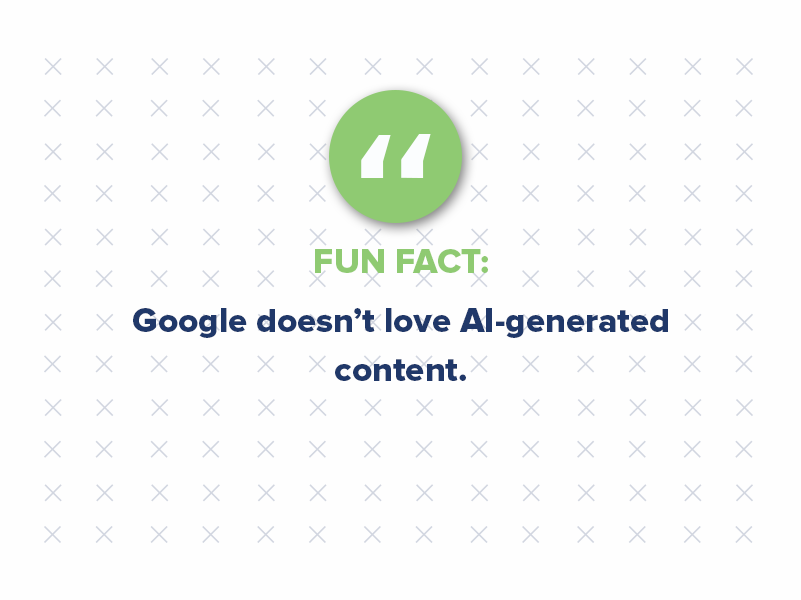
And did you know that Google punishes AI-generated content? That means anything a chatbot spits out will NOT boost your apartment SEO ranking. In fact, it’ll actually hurt it.
How will AI affect search?
Quality still matters over quantity. Just because ChatGPT can help you crank out more content does not mean you will rank well for those pieces. You need an SEO expert to help you rank and strategize effectively.

ChatGPT content lacks EEAT (expertise, experience, authoritativeness, and trust). You need this in your content to do well in Google search engine result pages (SERP).
Google provides users with TONS of answers to their queries based on SEO strategies, keywords, backlinks, etc.
A chatbot provides one singular answer. Just one answer. How does the chatbot know the ONE answer to that query? Is bias involved? What if they pulled inaccurate information for the answer? Consider these questions when using ChatGPT, Jasper.ai, Bard, and other tools to help generate answers to your queries and content for your blog.
Will AI replace humans?
No! Remember, ChatGPT requires human editing. Effective apartment marketing requires tapping into the human element, which is something AI can’t do (yet). Natural language processing could change this in the years to come, but for now, ChatGPT is more of a stepping-off point for your content.
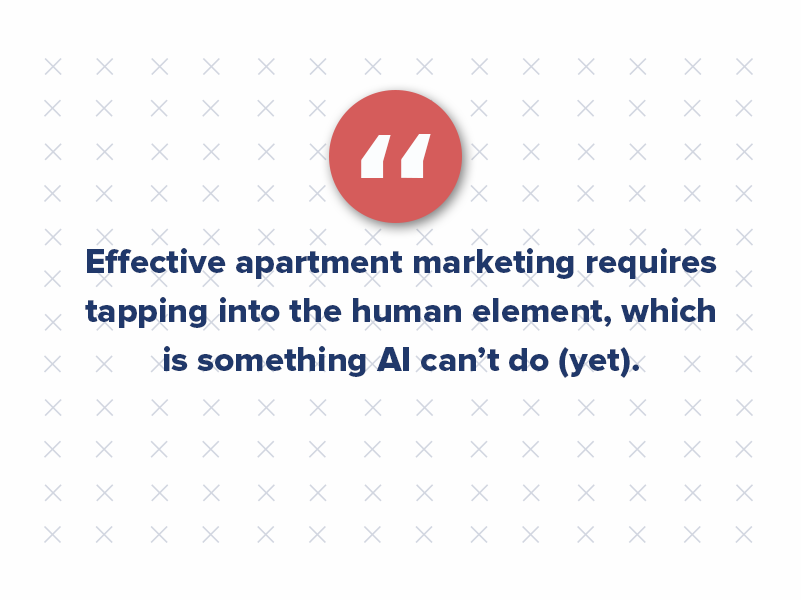
Marketers should harness AI to help batch-create content and save time, then use human editing to refine, hone, and detail the pieces. That’s how you create quality content that resonates. The key is to use AI for what it does best and supplement it with strategic human input.
How to beat your competition at the content marketing game.
So … outdated content, factual errors, plagiarism, and no guarantee of good SEO? That’s not a great recipe for your digital marketing strategy if you ask me.
ChatGPT is an excellent tool to start the writing process, but it should be viewed as a jumping-off point rather than a complete replacement for human writers.

There’s no replacement for human ingenuity. Over the next year or so, AI-generated content will explode. ChatGPT has changed everything, and it’s made everyone (including your competition) think they can pump out a bunch of content without their audience noticing.
But what happens when Google evaluates that content? It will notice the lack of originality. It will read like a robot wrote it — because a robot did! That’s what your competition is going to do. And what’s the best way to compete with your competition? Beat them at the content marketing game!
Want to see the effect the human touch can have on your content? Book a call with Criterion.B now. We’ll get started on your customized strategy and show you how to BEAT your competition with real-life, human-generated content personalized to your business and audience. We’re ready to chat and answer your questions!

Why Video Is Important for Your Apartment SEO
As technology continues to improve and become more ingrained into our daily lives, video has taken the main stage. Platforms like TikTok have made binging short, quick videos easy for anyone with a smartphone. YouTube countered this with its feature called “YouTube Shorts.”

However, video isn’t just for show. There are fundamental benefits that videos add to your apartment SEO efforts. Not everyone is energized by recording videos of themselves for their properties. However, these may inspire you to reconsider an SEO video marketing strategy.
Local Geodata of Videos
Similar to photos you take from your smartphone, videos capture embedded and local geodata within the files. For example, Brotherly Love Real Estate, a homebuyer starting in Philadelphia, PA, expanded to the west coast. They began their SEO video marketing efforts in Southern California, utilizing videos to help increase their rankings.
Brotherly Love Real Estate went to each city they wanted to rank in, recorded a video, posted it directly to YouTube, and placed it on their respective website pages. This website shows how they now buy and sell houses in San Diego from the success of their videos.
The geodata gets stored in the video file through location-identifying features from the smartphone. Google recognizes that, allowing it to carry weight when considering which multifamily website to rank for certain local search terms. It can feel tedious at times to record videos and then upload them. However, the results can be worth pursuing.
Increases Time on Page Through SEO Blog Writing
Another ranking factor that Google considers when determining which websites to show for a certain query is time on page. The more real, local users spend on your multifamily website, the more authoritative Google will consider you. They assume that if people spend tons of time reading through multiple pages or posts on your site, you must know what you’re talking about. Your content is viewed as credible, trusted, and rank-worthy.
Adding a video to your pages and posts is a great SEO video marketing strategy to encourage users to linger on your pages for longer. Over time, this will boost your apartment SEO. It also makes your SEO blog writing more robust.
Certain people prefer to learn audibly or visually. For these types of people, videos are sometimes preferred over long blogs full of text. Videos will add a different channel for your users to consume your content and get value from it.
Provide Additional Web Traffic
Google likes to see traffic from different channels (sources). For example, if your property website gets traffic from Google search, Twitter, and Pinterest, it will assume you are a more legitimate business than others that only get Google search traffic. This shows Google that people find you from different areas of the internet, which is a good sign. You can show traffic through your videos on both YouTube and TikTok. This will help boost your apartment SEO efforts.
Additionally, the more traffic you get to your site, the more other apartment SEO metrics can increase. Users can find you through YouTube and then begin crawling your property website. Your time on page for certain pages can increase.
Ideally, you can create a naturally flowing funnel for users to continue watching your videos. They can hop from YouTube into your property website through a link in the video description. From there, they can start exploring the other videos on your website’s different pages.
Shows Legitimacy
The more places you are around the internet, the more trustworthy you appear to search engines. If you have a large following of subscribers on YouTube or TikTok, that carries weight with your rankings. You are viewed as an authority in the online space regarding certain topics.
Your brand also appears more legitimate to the renters surfing your property website. For example, showing your face to potential apartment leads on your site will add credibility to your multifamily brand. They will naturally feel more comfortable with your apartment communities if a more personal connection is made through your SEO video marketing.
Users will be encouraged to continue crawling your website if they trust you. A high bounce rate is a negative factor to search engines. Bridging the gap of personal connection between your property brand and your users will decrease the number of people that bounce directly after hopping on to your site.
Videos encourage people to continue browsing other areas within your site, thus making it easier to get more prospective renters on your pages and convert them. SEO video marketing will only increase in popularity as we head into the future. You must keep up with this trend and use it to your property’s advantage.
Jenn is an experienced writer for the real estate industry and a house flipper for We Buy Houses in Denver. If she’s not swinging a hammer, she’s either writing about different real estate topics or reviewing investment property opportunities.
4 Things You Likely Didn’t Know About Multifamily SEO
There is no shortage of competition within Google’s SERPs in the real estate industry. As you niche into subsections on real estate, the competition becomes even tighter. Property management companies in the multifamily space must fight tooth and nail to reach the top of Google’s rankings and keep their position. With such intense competition amongst property managers online, you must have a clear plan on how to master SEO. The more relevant keywords your multifamily website shows up for, the more potential business you ultimately interact with.
Today, we will bust four surprising myths about multifamily SEO that you might be uncertain about.

1. No-follow Links Don’t Matter
Since many people within the multifamily SEO space would argue that backlinks are the most important ranking factor, it makes sense to start here. The last time that you had the opportunity to get a no-follow backlink pointing back to your site, did you accept? It is a myth that no-follow backlinks carry zero weight. There have been statements made in the past from people within the SEO space that no-follow links don’t pass domain authority. Many people stop here and don’t look any further.
While no-follow links do not pass domain authority, they do pass other great SEO signals that can help your apartment website. Additionally, large website publications like Business Insider only give out no-follow links. Suppose your property management business gets a link from Business Insider talking about how great and relevant you are to the multifamily industry. In that case, Google will see that as a great thing! You’re likely to experience a boost in rankings even though the link is set to no-follow. Although they don’t pass direct authority, plenty of other SEO benefits are passed, making these worth pursuing.
2. Viral Content Isn’t Worth Chasing
Google considers website traffic a huge ranking factor when ranking real estate companies. One way to get a huge surge of traffic is to create a viral piece of content. For example, property management companies of large multifamily buildings have created a funny, parody-style music video showing their property to potential tenants. Another common example of creating viral content is when people need to sell a house in the luxury real estate market. Real estate professionals will record flashy drone footage highlighting a mansion sitting on a massive estate. These eye-catching, memorable videos ultimately draw traffic to the website, which helps boost apartment SEO.
The cherry on top of making viral content is when the content is relevant to the local community where your property is. Not only will your multifamily website catch real, local traffic by legitimate internet users on legitimate IP addresses, but you also may generate a few apartment leads from it. Attempting to create viral content seems overwhelming at first. It’s hard to know where to start. If you can crack the code and generate something truly special, you will boost your multifamily website’s rankings and generate apartment leads.

3. No One Reads Anymore
The myth has some truth to it. Many people do not read anymore. However, some people surprisingly still do. That’s why creating meaningful, relevant, and useful content on your apartment website is important. Your goal is to create useful guides that address the needs of your target audience. Offer solutions to their needs, or at least useful perspectives, through engaging content.
You don’t have to only use words for your content. Switch things up and include videos, infographics, and other engaging features that you can include on a page. This will help keep users on your multifamily website from bouncing. If people leave pages once they arrive, it signals to Google that your site might not be that good. Keep your content relevant, engaging, helpful, and diverse.
4. Pictures Don’t Matter
A picture says one thousand words, right? Pictures matter in SEO for several reasons. The quality of the photo is important to gain trust and credibility once someone hits your site. If you’re using too many stock photos, that will turn people off, and they will likely bounce. Add photos of your property to help encourage people to rent from you.
Pictures also play a role in your local SEO efforts. Google picks up geotags from photos depending on where they were taken. Depending on how the image was transferred, saved, edited, or added to the site, it could remove the geo-tag. For property managers that want to show up for local keywords, it’s important to have geo-tagged photos throughout your multifamily website. That tells Google, in the background, that you are a legitimate, local business and not a scammer.
Multifamily SEO Is a Moving Target
No matter how much you dial in your multifamily SEO efforts, new algorithm updates will emerge, and things will change. Google has a great way of keeping multifamily marketing professionals on their toes. As you dismiss myths within the online space, new ones will arise that you’ll be forced to create an opinion on. Test and measure things as often as possible without breaking your website. This will help you improve your website’s health, SEO, and rankings.

Jenn is an experienced writer for the real estate industry and a house flipper. If she’s not swinging a hammer, she’s either writing about different real estate topics or reviewing investment property opportunities.
Our Top 10 Tips to Increase Your Ranking in Google SERP
If you manage a multifamily property, you know how important it is to be visible online. After all, potential residents will likely start their search for a new place to live by turning to the Internet. But with so many properties vying for attention, how can you ensure that yours stands out from the rest? The answer is multifamily SEO.
SEO, or search engine optimization, is improving your property’s ranking in Google and other search engines. Following a few simple tips, you can ensure that your property appears at the top of the search results when potential residents are looking for a new place to live.

Solving the Mystery of Multifamily SEO
The mysterious art that is multifamily SEO is not that mysterious at all. From this perspective, things become a little clearer when we think about multifamily SEO. We all do searches and all happen across results less than valuable to our needs.
Google only cares about one thing and one thing. Relevance. That is it — just relevance. They do not care about you or your multifamily business — they only care about the person searching.
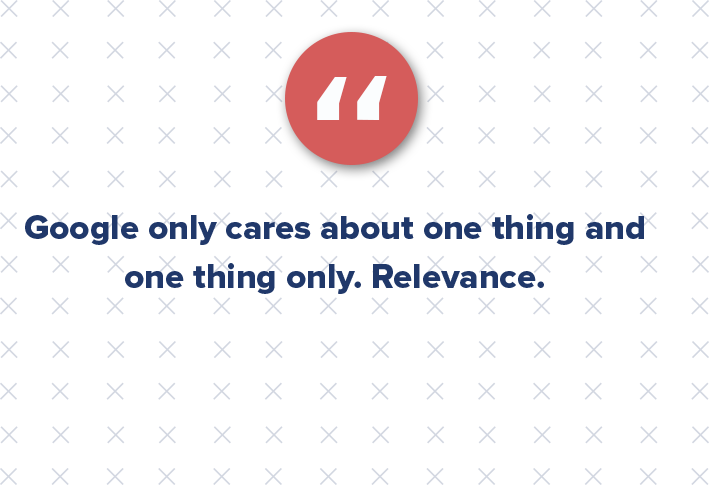
Google’s job is to get the user the best results as quickly as possible. It is not easy when so many people are trying to game the system to increase traffic to their site. Google gives us one directive, “Be Relevant.”
From time to time, you hear about Google’s major algorithm updates and descriptions of what they do from a technical standpoint. You need to know less of the technical aspects and more of the overarching strategy — relevant content. If you can follow that advice and do it well, you will find yourself rising in the ranks of Google.
So you want to know how to do it well? Do you want to know the secret to get your multifamily business listed?
Just follow these SEO tips to improve your ranking in Google:
1. Create remarkable content
Remarkable content is sharable content. You want your content to be so good that people want to share it with their friends, families, and others within their circle of influence. This, while a little daunting, may be simpler than you think. You can start by identifying pain points that your prospective renters may have and give them a solution.
Your content shouldn’t be about driving a sales pitch, it should be about educating. Add value to your viewers. They will appreciate it, and in turn, pass it around to those within their circle of influence.
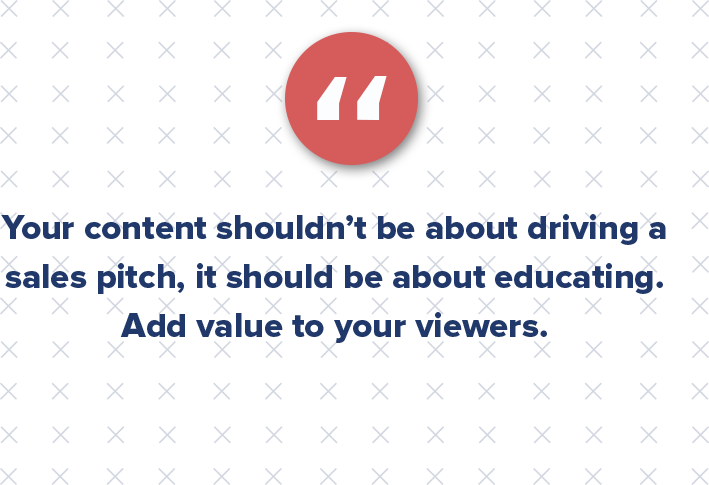
2. Create a catchy, relevant headline
Your headline is your first impression, and first impressions count. It’s just as important as having a strategic meta description and title tag. You want your headline to be catchy and engaging but also contain your primary keywords.
Try using numbers combined with the primary keyword you are trying to rank for. People are drawn to lists because they are faster reads, such as:
- 5 Ways to Decorate Your Luxury Apartment in Dallas
- 10 Steps to Declutter Your One-Bedroom Apartment
- 30 Things to Do in Charlotte, N.C. This Summer.”

3. Always include a call-to-action (CTA)
Throughout your blog, or at least at the end of it, provide a way for your viewers to get more helpful information by providing you with a little bit of information. Give them something of value for providing you their name and emails, such as a whitepaper on the “Top Multifamily Market Trends of This Year,” an infographic on “What Amenities Your Residents Really Want,” or perhaps an eBook on how to win more business by using your multifamily product or service. (Psst … a great example of a marketing offer is the one you see promoted throughout this blog!)
This is one way to help identify which content is truly remarkable and what is not. When someone fills out your form requesting additional information, this is what we like to call an apartment lead — it shows interest!
4. Distribute your multifamily content
Simply put, don’t just post content to your site and leave it at that. Get the word out. Post a link across your social channels, send it out in an email blast, and get your coworkers and others in your circle to post it. This will create a buzz around your multifamily business, and you will start seeing a spike in traffic to your site just because of this. Every post you make needs to include social sharing icons, making it easy for your viewers to share it. The easier it is to share, the wider your reach.
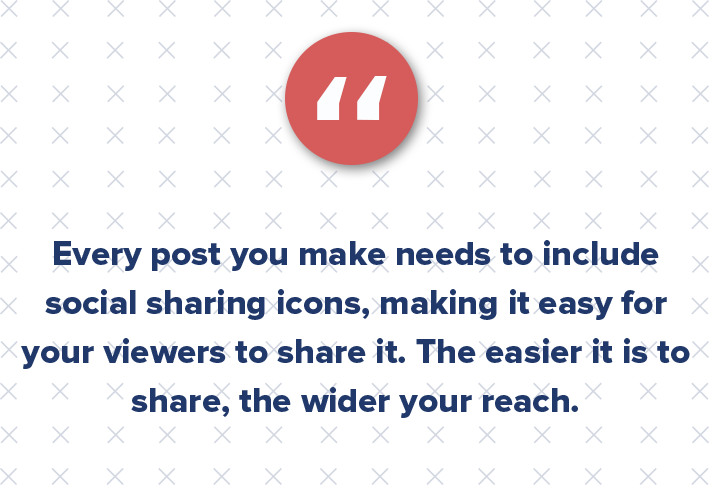
5. Enhance your outreach backlink strategy
Distributing your content is also a great strategy for enhancing your backlink strategy. A backlink is a link from another website to your multifamily website, web page, or web directory. This is comparable to a citation. These backlinks are critical to any good multifamily SEO strategy as it shows Google that your multifamily website has authority and relevance in the market.
By getting the word out about a new blog you published, for example, you increase your chances of similar websites linking back to your content and increasing your authority with Google (and thus, your ranking!) Distributing your content and reaching out to similar publications are two easy (and free) ways to increase your backlinks.
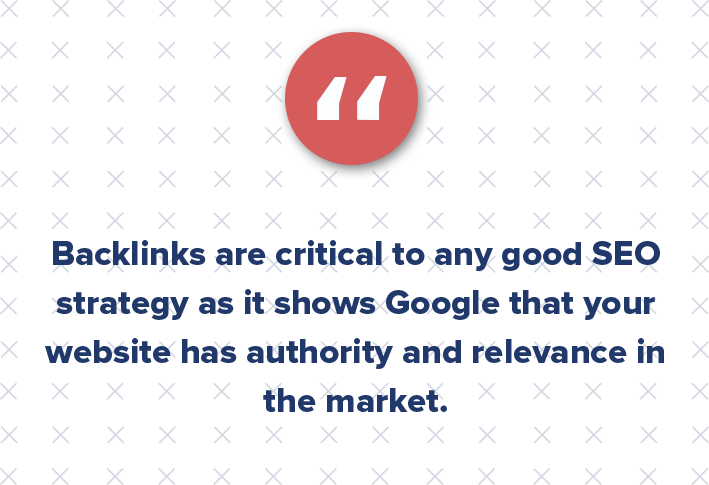
Just be very cautious about blackhat multifamily SEO tactics that could harm your rankings, such as irrelevant and spammy backlinks.
6. Encourage commenting and respond to comments
This point is not that hard, invite viewers of your content to leave you feedback through comments. This provides a great way to build relationships with prospects interested in using your multifamily product or service. These comments can come from social media or your multifamily website.
7. Claim your Google Business Profile
Google Business Page (formerly Google My Business) is a free service offered by Google that allows businesses to manage their online presence. When you claim your listing, you can control what information appears about your property when it comes up in a search. Ensure all of your property’s information is accurate and up-to-date, and take the time to respond to positive and negative reviews.
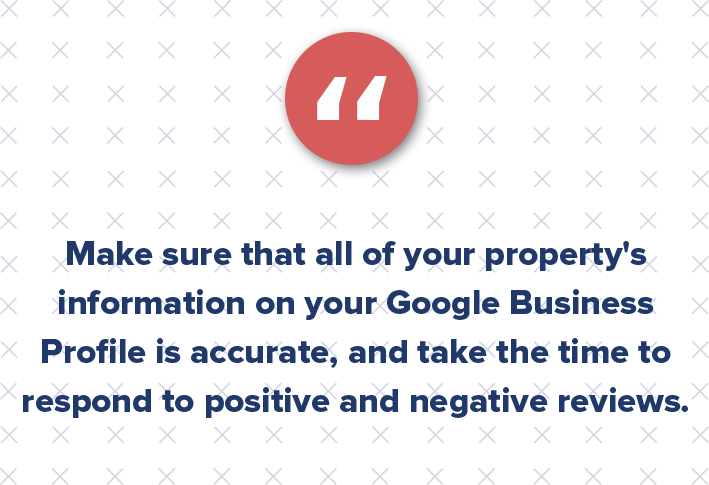
8. Optimize your multifamily website for SEO
Your multifamily website should be designed with SEO from the beginning. That means incorporating relevant keywords into your content, ensuring your site is easy to navigate, and ensuring all your content is original and error-free. You should also ensure that your site is mobile-friendly, as more and more people use their phones and tablets to access the internet.
9. Get involved in local community events
Local community events are a great way to get your property’s name out there. Sponsor a Little League team, host a food drive or partner with a local charity. Anytime you can get your property’s name in front of potential residents, you’re increasing the chances that they’ll remember you when they’re ready to start looking for a new place to live.
10. Make use of social media
Social media platforms like Facebook, Twitter, Pinterest, and Instagram are great ways to connect with potential residents and create an engaged online community around your property. Use social media to share your property’s news updates, highlight available units, and promote community events.
And don’t forget to respond quickly and courteously to any questions or concerns posted on your social media accounts — you want potential residents to know they can count on you for excellent customer service.
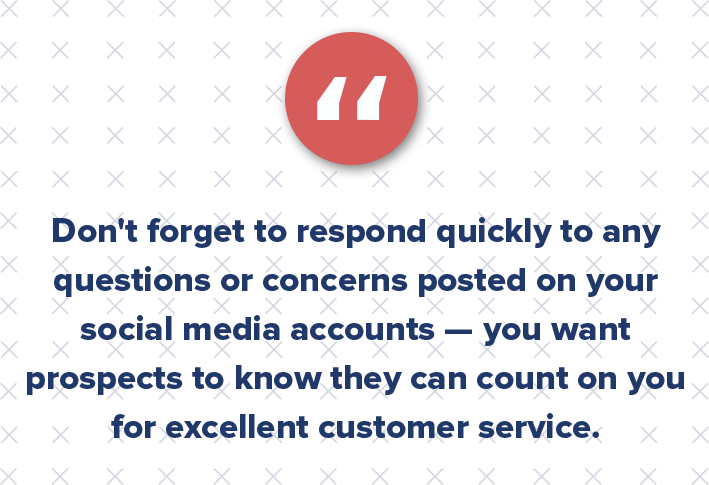
Writing Remarkable Content to Earn Higher SERP Rankings
To sum up, there is nothing magical about these SEO tips. As a wise man once said, “If it is not worth doing right, then it’s not worth doing.” Writing remarkable content to improve your multifamily SEO takes time and effort, but it ultimately pays off.
Following these simple SEO tips can improve your multifamily property’s ranking in Google and attract more attention from potential residents. Investing in SEO will pay off in the long run as you see an increase in traffic to your website and ultimately lease up more units at your property.

Understanding the Relationship Between Multifamily SEO and Social Media
Did you know that multifamily SEO matters on social media?
More and more multifamily properties are hopping on social media, which serves as another channel for them to share and interact with renters and the community. But perhaps you don’t see the appeal of a social media presence?

Well, we’re here to give you another very important reason to be on social media, and that’s search engine optimization (SEO). Multifamily SEO is essentially the process of optimizing your content for search engines.
For most platforms (i.e., Instagram, Facebook, Twitter, Pinterest, and Tumblr, to name a few), there are a few simple steps you can take to move your multifamily property up in search engine rankings:
How do you optimize your social media profiles?
1. List Basic Information
All social media platforms have a place for users to list basic information: Company Name, Location, About Us, Address, etc. Make sure to fill out all the information sections on your profiles with specific keywords. The more information you share, the more chances you have to be indexed by Google. Besides, you want to make sure that anyone who comes across your property online knows exactly where it’s located and how to contact you.
2. Anticipate Popular Keywords
Brainstorm words or phrases that are relevant to your multifamily property. Perhaps it’s “lofts in downtown Dallas” or “Houston apartments with a dog park.” What is your property or multifamily business offering? What would your target audience search specifically? Use these keywords at a high density throughout your social media profiles and bios; include them in your social media captions when it’s natural to do so. You also might want to use them in hashtags (within the caption and not the comments) to get users on social media to find you more easily.
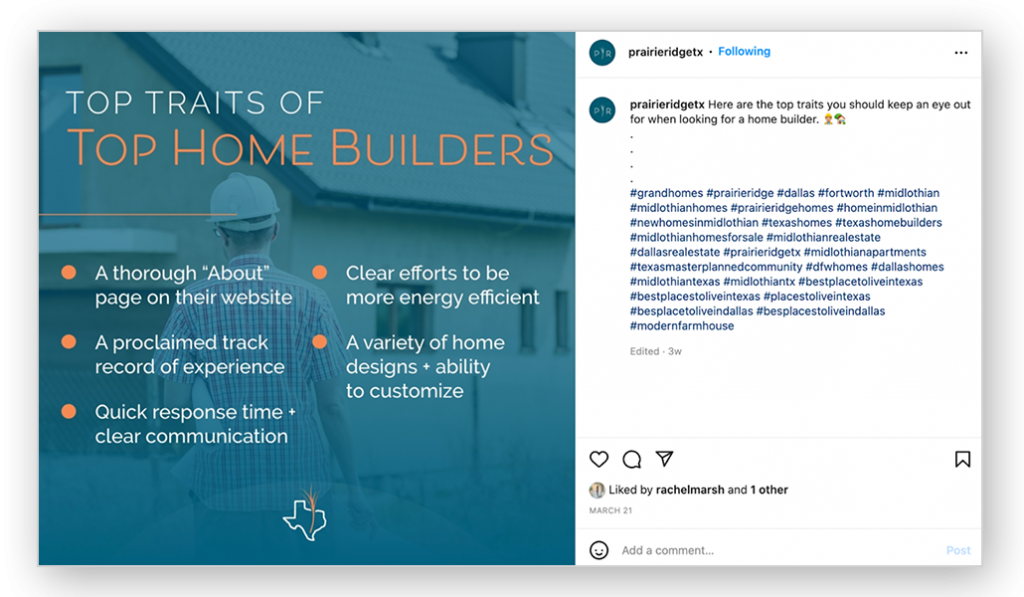
3. Invite Reviews
Display a section for reviews when possible. Facebook pages have a review section on the left side panel with 1-5 star ratings for the user to evaluate and post comments. It shows real people living in your multifamily property, providing real feedback. Again, it’s more opportunities to be indexed by search engines. This also allows you to publicly address any issues that your residents may be having, ultimately showing potential residents that you’re on top of handling problems.
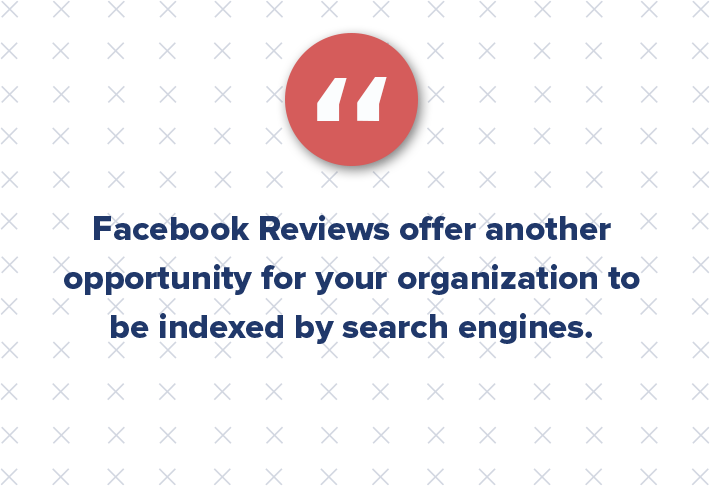
4. Link Often
Outbound links are one of the most important aspects to multifamily SEO, so be sure to link to other sources! In your use of social media, provide links to relevant blog articles and neighborhood events. Spread the word out about the great happenings going on around your neighborhood and property. Not only is it good for multifamily SEO, but “linking” is a great way to connect with people and businesses in your community.

5. Create Shareable Content
Inbound links are equally as important to SEO, yet you have to earn them. When people link back to your multifamily website or social media pages, it means you’re sharing content that is high quality, compelling, and helpful.
Some ideas include:
- Make and share a weekly newsletter with information about what’s going on at your property.
- Post interior design tips for small living spaces.
- Write about apartment decorating and storage hacks.
- Promote local events and happy hour specials in your community.
Creating shareable content starts with knowing your audience and what they would find interesting and resourceful.
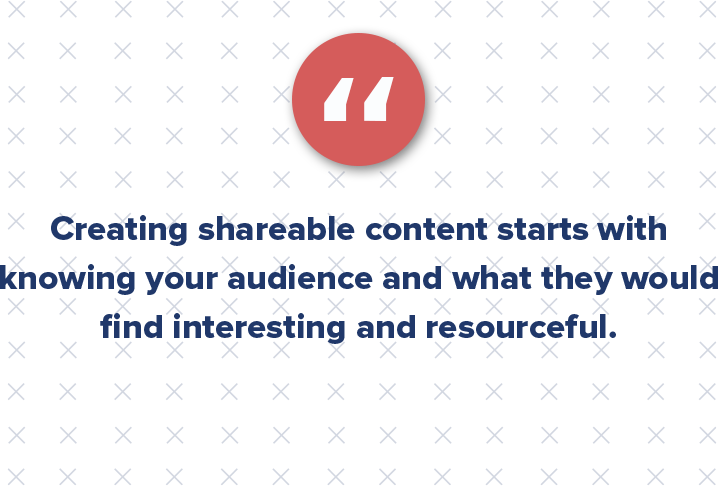
6. Utilize Multifamily PPC
While SEO is the organic approach to driving traffic, multifamily PPC is the paid. PPC ads display at the top or in the sidebar of search engine results. A successful multifamily PPC campaign combines your keyword research and your insights to design highly targeted ads that drive traffic to your website. It’s important to note that well-qualified traffic is the result of research and continued testing. Understanding your residents should be an ongoing learning process and the foundation of any SEO or PPC campaign (not to mention, all digital marketing).
7. Update Your Instagram Bio
Potential renters don’t just use Google to find new apartments, they use Instagram too. They go to the search bar on the explore page a type in “apartments in [city]” and maybe even include a descriptor such as “affordable” or “luxury.”
The way you give your property’s account the best chance of showing up in a related search is by adding keywords right into the “Name” of your profile’s bio. While the label for this section might make you assume you’re limited to just having your property’s name, there are actually no rules for this section. You can put whatever you want for your bio’s name. There’s also quite a bit of space you have to work with.
Here are some examples:
- Rio Villa Apartments | San Angelo, TX
- LVL 29 | Luxury Apartments in Plano
- Willow Creek | Affordable Apartments in Austin
- Prairie Pride | New Homes in Midlothian
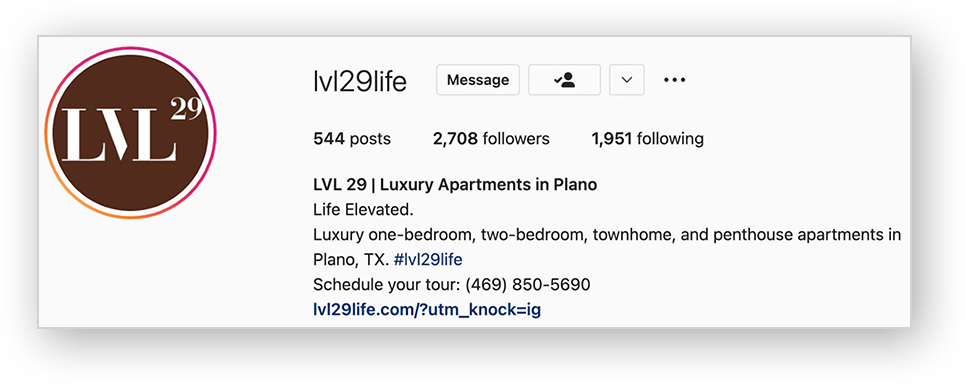
If you feel like your Instagram handle is enough to communicate the name of your property, you could even remove the name entirely and focus more on longer or multiple keywords.
Following these simple steps is a great way to improve your search engine ranking with the social media platforms you’re already using. It ultimately makes your content easier to find, allows you to connect with your audience, and helps you build the brand that you’re striving towards.

